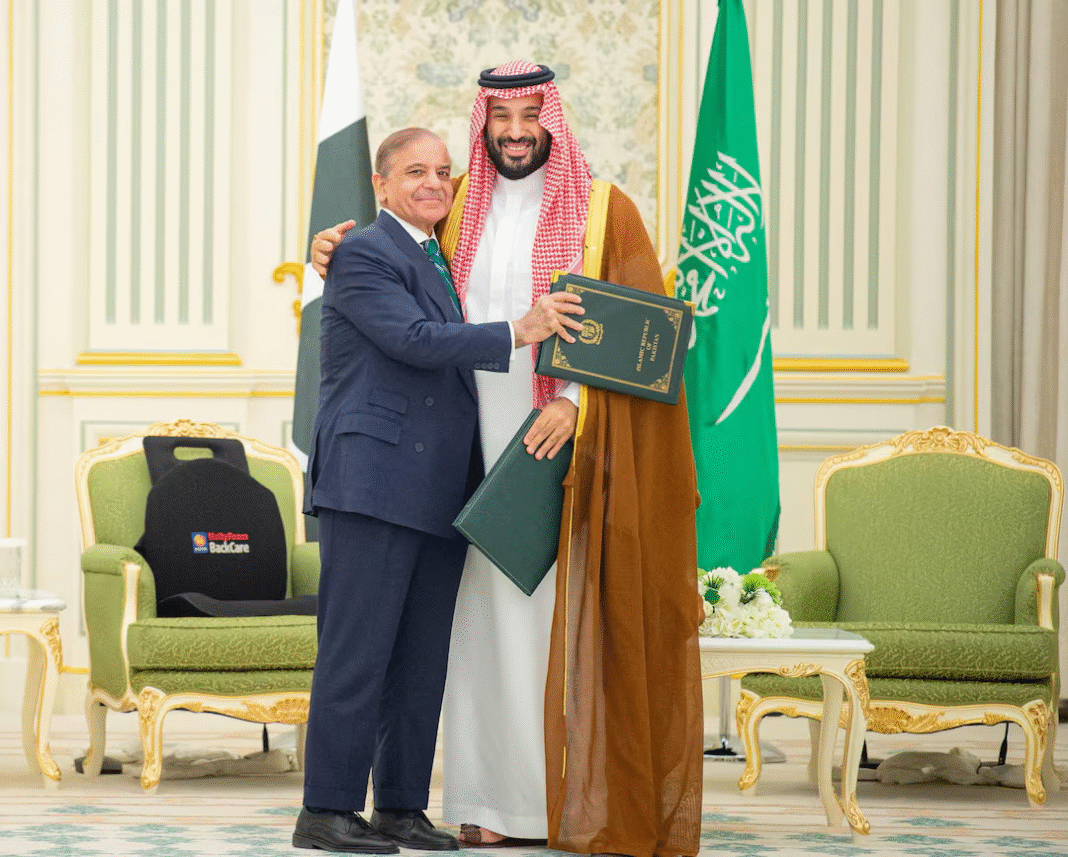Historic pact: Pakistan and Saudi Arabia sign “Strategic Mutual Defence Agreement” — what it means for Pakistan, the region and beyond
In a landmark move that cements one of Islamabad’s closest strategic partnerships, Pakistan and Saudi Arabia on 17 September 2025 signed a Strategic Mutual Defence Agreement in Riyadh. The agreement — signed at Al-Yamamah (Yamama) Palace by Prime Minister Shehbaz Sharif and Crown Prince Mohammed bin Salman — contains a central pledge: any aggression against one country will be treated as aggression against both.
Below is a detailed explainer for Buzz Pakistan readers: what the pact says (and doesn’t), why it matters now, immediate reactions, possible scenarios, and what Pakistanis should watch next.
The basics — what the agreement contains
- Core clause: The agreement formalises a mutual-defence pledge: an attack on one country will be regarded as an attack on both. The governments say the pact aims to “develop aspects of defence cooperation” and “strengthen joint deterrence”.
- Where & when: Signed 17 Sept. 2025 at Yamama Palace in Riyadh during PM Shehbaz Sharif’s state visit.
- Characterisation by media & officials: Coverage describes the pact as “comprehensive” and as institutionalising decades of bilateral security ties rather than a sudden reaction to one event. Saudi and Pakistani statements emphasise historic brotherhood, defence cooperation and shared strategic interests.
Key ambiguities — what the text does not (publicly) clarify
The headline clause is clear. But several important operational and legal questions remain unanswered in the public domain:
- Triggers & thresholds: The precise legal definition of “aggression” (state actor vs. non-state actor, cyber attacks, cross-border incursions, proxy actions) is not publicly spelled out. Who decides whether an event qualifies for a joint response — political leaders, military chiefs, or both — is unclear.
- Scope of military assistance: While reports say the pact allows use of “all military means deemed necessary,” the operational modalities — troop deployments, basing rights, logistics, airspace access, and rules of engagement — haven’t been released.
- Nuclear question: Crucially, public documents do not explicitly confirm whether Pakistan’s nuclear deterrent is being extended as part of the guarantee. Several outlets note the strategic sensitivity of that topic and describe it as ambiguous in public statements. Analysts warn the very possibility introduces regional strategic complexity.
Why now? The immediate drivers behind the timing
Analysts point to a cluster of regional and global dynamics that help explain the timing:
- Middle East security recalibration: Gulf states — especially after incidents that heightened regional fear (such as the recent Israeli missile/airstrike activity that alarmed regional capitals) — are reassessing security guarantees and diversifying alliances. Reports say Gulf governments have become anxious about the reliability and predictability of external security guarantors.
- Deepening of an already long relationship: Saudi–Pakistan military links have a decades-long history (training, cooperation, financial ties). This pact codifies and elevates those ties into a formal mutual-defence arrangement.
Reactions — immediate diplomatic and domestic signals
- Pakistan: Islamabad framed the pact as strengthening national defence and regional stability; PMO and state media emphasised the historic partnership and joint deterrence objectives.
- Saudi Arabia: Riyadh says the pact reflects shared strategic interests and is intended to enhance security while supporting regional peace. Saudi official statements stressed it is not targeted at any specific country.
- India: New Delhi has said it will “study the implications” for its national security and regional stability — a measured response that signals concern but avoids immediate escalation.
- Global observers: International media note the pact could be interpreted as part of a wider Gulf trend to diversify security partnerships, and flag potential non-proliferation and strategic stability questions if nuclear dimensions become explicit.
What this could mean — short and medium term scenarios
1) Low-escalation — formalising the status quo (Most likely near term)
The pact codifies existing cooperation (training, logistics, intelligence) without operationalising a nuclear guarantee. States continue diplomatic engagement; tensions remain manageable because the document serves mainly to deter low-level threats.
2) Risk of strategic ambiguity leading to miscalculation (plausible)
If the pact remains vague—especially on what counts as “aggression” and whether nuclear measures are part of “all military means”—neighbouring states may assume worst-case responses. Ambiguity can deter some rivals but also increase the risk of misperception in a high-tension episode (e.g., cross-border skirmishes).
3) Escalation if nuclear linkage is clarified (low probability but high impact)
If future communications or operational steps suggest Pakistan’s nuclear deterrent would explicitly cover Saudi defence, that would be a strategic game-changer — raising strong reactions from regional powers and non-proliferation watchers and complicating India’s and Iran’s threat calculations. Current public reporting does not confirm this, but it remains the most sensitive variable.
Why ordinary Pakistanis should care
- Security assurance: The government will present this as enhanced security backing. For many citizens, the pact will be viewed as geopolitical insurance.
- Economic & diplomatic costs/benefits: Deeper defence ties may come with increased military cooperation and defence procurement. At the same time, closer Saudi ties can yield economic benefits (investment, oil, remittances), which governments will emphasise.
- Regional risk: Formal mutual defence pacts can raise stakes in regional crises; Pakistan will need to weigh alliance commitments against domestic priorities (economy, social spending).
What to watch next — 7 concrete signals
- Official text publication: Will Islamabad or Riyadh publish the pact text (timing, scope)? If so, read the legal definitions closely.
- Statements on nuclear policy: Any official clarification about nuclear commitments would be decisive.
- Joint military exercises or basing agreements: Announcements of new drills, basing, or logistics hubs would indicate operationalisation.
- Parliamentary debate in Pakistan: Will opposition parties press for debate or details on costs/liabilities? Domestic politics will shape implementation.
- India’s policy moves: New Delhi’s military posture or diplomatic outreach to Saudi/others will show how the pact affects South Asian calculations.
- Gulf diplomacy: Watch whether Saudi Arabia clarifies that it will maintain ties with other regional powers (e.g., India, Iran) to reduce fears of binary alliances.
- International reactions on non-proliferation forums: If nuclear questions arise, expect commentary from the IAEA, Western capitals, and think tanks.
Quick expert read (concise)
- Deterrence boost: The pact gives Riyadh and Islamabad a high-visibility deterrence message.
- Ambiguity risk: Lack of operational detail creates strategic uncertainty and potential misreading by rivals.
- Diplomatic balancing: Saudi Arabia will try to reassure other partners (including India and Western states) that this is not aimed at upsetting regional balances.
Bottom line
The Strategic Mutual Defence Agreement is a major diplomatic milestone that cements decades of Pakistan–Saudi military cooperation into a formal commitment. It sends a robust deterrence message and reflects shifting regional security dynamics. But the pact’s long-term effect depends entirely on the operational details that remain unpublished for now — especially around definitions of “aggression” and any implied nuclear guarantees. Pakistan’s government will need to manage both domestic expectations and regional sensitivities as this pact moves from headlines to implementation.



